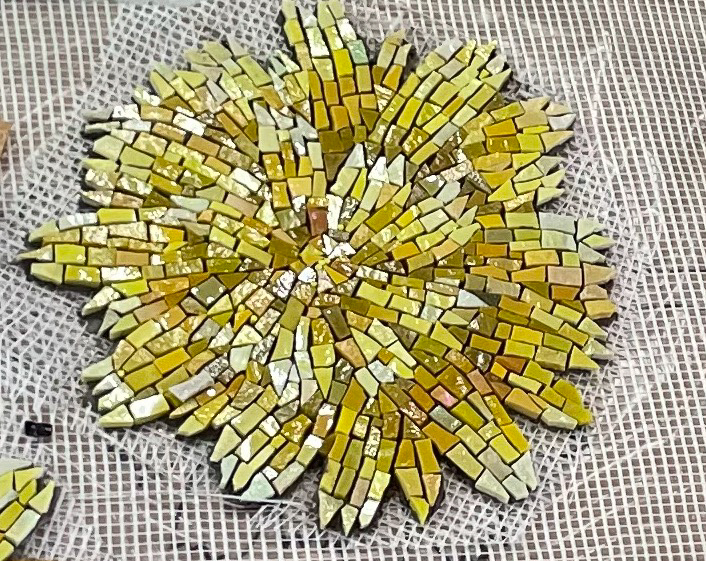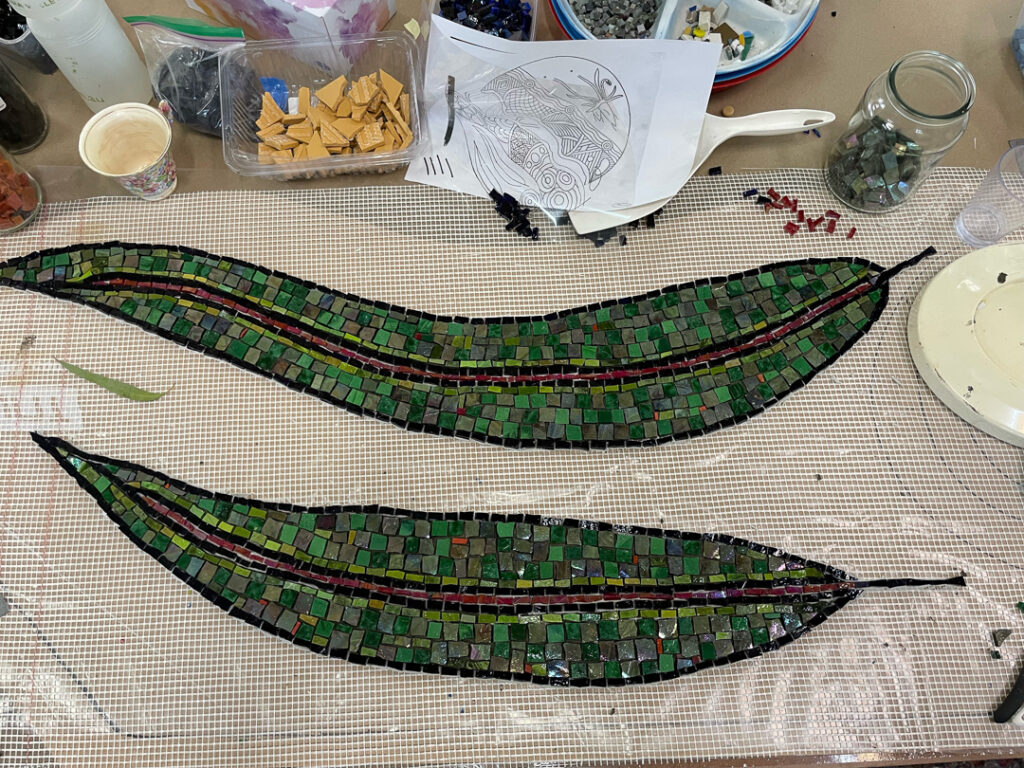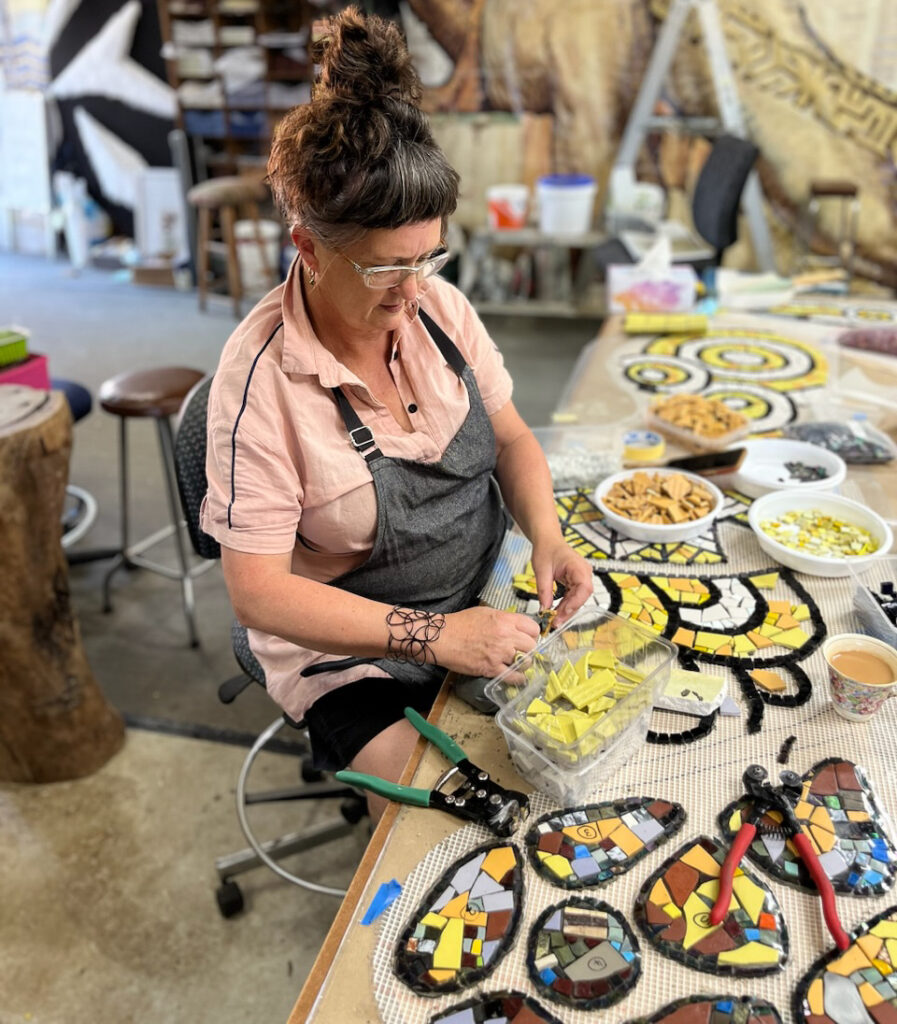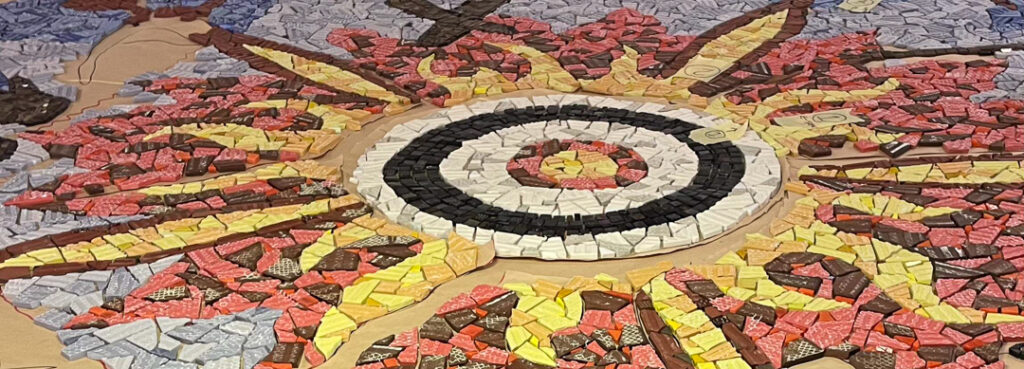Francesca Bussey writes about listening and talking about mosaics, middens, and that which is bigger than all of us.
In the front parlour of Eastern Beach Art House in Geelong, Victoria we sit down to talk, our faces bathed in the glow of wooden wall panelling and red velvet upholstery.
I’m sitting next to Aunty Lee-Anne Clarke, a Kirrae Whurrong woman of the Eastern Maar people of Southwest Victoria, an artist, and Elder who is sharing with me the sketches and ideas behind the public artwork installation, The Five Elements. Across from us is her collaborator and friend Dr Helen Bodycomb, an internationally renowned mosaicist and artist, teacher and author who has delivered us tea and promised cake. Our skin is still salty from a dip in Eastern Bay, yet the humidity is such that our bodies have returned to their pre-swim sponginess. Our foreheads glisten with a light sheen of sweat; we bead, as my mother would say.
Despite the heat, I am enraptured by the painting and sketches Aunty Lee-Anne shares with me, falling headfirst into these depictions of eternal cultural knowledge as she unravels their meaning. We are examining the plans of one section of The Five Elements installation, Fire, a raised octagonal 2300 mm diameter mosaic reminiscent of a mandala that, alongside its four companions, Air, Spirit, Water and Earth, speak to Indigenous ways of knowing and being.
As we talk, Aunty Lee-Anne runs her fingers around and across the circles and symbols that radiate from the centre of the work, explaining their significance as we go, her soft voice ebbing and flowing—pointing to a spear here, an ancestor there, and confirming my comprehension with gentle questioning and redirection. Sometimes she reads from her submission to Brimbank Council, which commissioned the work in 2019 and sometimes she waits in silence while I absorb the story.
At the centre of the work is the symbol of a dot with two circles surrounding it. Aunty Lee-Anne tells me that this symbolises the campfire around which mob gather to find gumleaf healing in smoke and connection. Working outwards from the campfire are further circles each depicting different layers of interconnected relationships—animal prints, human hands, spears and clapping sticks. The ancestors dance beyond these symbols, their figures cradled within circles representing Country. Mountains, water, and sky revolve at the very edge of this circular orb.
This is deep time and in contradistinction to contemporary cultures of individualism and disconnection from nature, I feel comforted, but also destabilised and slightly dizzy. Aunty Lee-Anne is spinning a new universe for me, one of rich meaning and purpose that eclipses the day-to-day worries of temporal contemporary existence.
But of course, this is not new knowledge; it is grounded in tens of thousands of years of Indigenous knowing.
- Close up of Murnong daisy (Yam Daisy), Earth, The Five Elements.jpeg
- Francesca Bussey – Earth under construction, The Five ELements
- Gum leaves under construction, Earth, The Five Elements
The Five Elements was originally installed on Wurundjeri Country in 2019, in the newly established Sunvale Community Park. Created by Aunty Lee-Anne and Yorta Yorta/Barappa Barappa/Wemba Wemba woman Mandi Barton, with guidance from Wurundjeri Elders, the work was rendered in painted concrete and steel. Comprising five large octagons, each 2300 mm in diameter, it was hailed as an important commitment to recognition and reconciliation. The full installation was situated in bushland in the park, each circle telling a visual story distinct in and of itself which you can read about here.
In 2020, with Victoria deep in the grips of Covid, it was destroyed by a homeless person suffering from mental health problems. Aunty Lee-Anne is empathetic about the circumstances: Covid was hard on most, and particularly so for the very vulnerable. Despite this, she and her collaborator were hit very hard by what seemed like an assault.
We talk about the making of the work, the creative imagining, the intricacies of ensuring protocols were in place, the process of applying to Council, and the hard graft inherent in the making. We talk also about the depth of feeling captured in the installation itself and particularly about the broader significance of the work: an encapsulation of deep knowledge held against all odds by the oldest continuing culture in the world.
- Aunty Lee-Anne and Helen working on Fire The Five Elements at Lot 19 Castlemaine
- Aunty, Lee-Anne and Helen, installing, Spirit-The Five Elements
- Fire The Five Elements Aunty Lee-Anne Clarke & Helen Bodycomb
- Fire The Five Elements Aunty Lee-Anne Clarke & Helen Bodycomb
The work has been recommissioned by Brimbank City Council and will return to place this year. For the new commission, Aunty Lee-Anne is collaborating with Helen to create a re-working of the original piece, this time in mosaic, using traditional Greco-Roman techniques.
For both artists, this collaboration is unusual. Aunty Lee-Anne has not worked much in mosaics before and will be learning through the process. She will also be teaching Helen about the significance and meaning behind the work they are engaged in. This includes not only the timeless knowledges of Indigenous peoples, but also more practical understandings such as protocols for working with Elders and community.
Although Helen often collaborates with other artists on larger projects, she seldom makes artworks designed by another artist. Also rare, is the opportunity to work closely with a keeper of First Nations stories. For Helen then, the practices of art making, and cultural understanding are growing in tandem through the process. Helen is also learning to resist the deep cultural underpinnings of a colonising culture: the linearity of time and space, of human primacy in the world. Like me, Helen is opening herself to different approaches. She is respectfully leaving space for collaboration and learning, whilst I am listening with all my senses. In working together in this way, both artists say they are being driven by something that is bigger than either of them.
The re-building of The Five Elements is subtitled Healing Country, which speaks to the extraordinary persistence and generosity of Indigenous peoples. Healing Country grounds and binds the five mosaics, each illustrating through story the primacy of Country and the interconnectedness of the Wurrundjeri with that Country.
Healing Country leads us to the notion of Caring for Country, which for many has become a much-used phrase, arguably broadly misunderstood by non-Indigenous people. We talk around this and Helen, who has been quiet for a while, suddenly starts talking about a childhood memory. She is at her weekly flute lesson and mid-way through a fairly advanced piece, remembers feeling proud and confident in her rendition. Abruptly, her teacher stops her: “Your playing is careless, Helen. Listen to the music, feel it. Slow down. Take care.” We talk about the significance of this, of what taking care means, but I am wary of letting myself drift into some kind of self-care, well-being thinking, which has become significantly commodified.
The idea of Caring for Country though, of being care-full, does lead me to thinking about the physical process involved in making mosaics. Whilst I have never so much as picked up a mosaic hammer, Helen’s book Mosacism: Thinking in Mosaic has already introduced me to the painstaking work involved in making mosaics at the level to which she. So, I ask about the process, because I imagine that the physical act of building the mosaic is almost meditative—a careful immersion in a shared practice. Both artists nod in agreement, with Helen elaborating a little on the various processes involved in executing the finished work.
First, a design is agreed on and then something called a Cartoon is drawn up, a full-size map of the mosaic that may include detailed information on the construction. Then, one by one, each tile or piece of glass (called tessera in the language of mosaics), is methodically set in place with tweezers. Tesserae (plural) are laid together in consideration of chromatic and tonal nuance, using different colours and textures to achieve a pointillist technique. The gaps between each tessera are also important, these are called interstices and function at a practical level to support mechanical adhesion and also as part of the broader design. As Helen explains: “The role of the interstices is not unlike the role of the musical rest; rather than a space where nothing happens, it functions … as a visual pause” (from Mosacism, p. 10.)
Meditative, then, may go some way to explaining the effect on the individual when ‘doing mosaic’, but it is clearly more than this. As both artists explain:
The practice of making mosaic entails a gradual, meditative process. Like many other crafts, it is practiced in slow time — cut by cut. Each colour is chosen and each tessera cut, both in terms of what has already been laid, and in anticipation of what is yet to be laid. And like many other crafts, large mosaics are often made by more than one person. This shared, methodical collaborative craft practice naturally becomes a part of a social well-being and a cultural exchange process.
The recommissioning of The Five Elements then, has not only been a space for Aunty Lee-Anne and Helen to connect their respective practice and to learn from each other in the comforting space of a shared activity. It has also allowed them to deepen their relationship in a way perhaps only ever possible through a shared experience of creating something of meaning.
“The work is bigger than both of us”, Helen says. Aunty Lee-Anne nods in agreement and they smile broadly at each other.
✿
The significance of the setting in which we meet to talk about The Five Senses is lost on none of us.
The Eastern Beach Art House was built by Geelong timber merchant, Thomas Higgans in 1909, a tangible expression of the potential for settlers to achieve wealth and advancement in the colony of Australia. Replete with gabled roofs, attic dormers, a tower and decorative internal woodwork, it is a beautiful building but can be described as nothing less than a bastion of colonialism.
As we talk about the irony in holding our discussions here, Aunty Lee-Anne looks towards the glass entry doors which lead us to the bay and says quietly that she can always feel mob when she visits here; the ancestors sitting around campfires, yarning, and feasting on the plentiful bounty of the bay. We sit in silence for a while, each acknowledging in our own way the sadness that this surfaces.
In late 2023 the Voice to Parliament referendum returned a resounding No, meaning that the majority of Australians rejected the right for Traditional Owners to advise parliament on matters pertaining to their own peoples. We discuss for a while the politics that impacted this result, and I ask Aunty Lee-Anne if it’s okay to discuss the No result in the context of this article. She agrees so kindly and generously, that I find it hard to speak.
The emotions that Aunty Lee-Anne experienced on the night of the referendum are hers alone to relate. For our purposes, it is enough to point to the deep wounding that the No result delivered, one that echoes the assault and destruction of the original Five Elements some three years earlier. As Aunty Lee-Anne and Helen continue with the work of re-making, re-establishing and re-telling cultural knowledge from the oldest continuous culture in the world, its amended title Healing Country: The Five Senses seems not only poignant, but also incredibly generous. I am left with a sense of immense gratitude to Aunty Lee-Anne, whose grace and fortitude is so remarkable that I feel hollowed out.
A light breeze finally starts making its way into the parlour at Eastern Beach Art House. Beyond its velvet and wood panelling lies the bay, once peppered with ancient middens stretching back more than 50 thousand years. It seems now a room out of sync with its environs as it shifts uncomfortably on its foundations while the weather cools. I’m reminded in this way, of the nature of this work in which, as both artists explain, “millennia-old Greco-Roman mosaic techniques have been humbled and dwarfed by immeasurably more ancient cultural knowledge”.
As though in conspiratorial agreement, the implacable gaze of a Greco-Roman head rendered in mosaic surveys me from the mantlepiece. Its eyes seem to glimmer in the fading light.
Further Reading
Bodycomb, Helen, (2022), Mosaicism: Thinking in Mosaic, Helen Bodycomb Press.
Langton, Marcia, (2021), Welcome to Country: A travel guide to Indigenous Australia.
Yunkaporta, Tyson, (2021), Humans as a custodial species | Garland Magazine
Additional Resources
The Five Elements: details of the original installation pre-2020.
Helen Bodycomb: Helen’s website.
The City of Geelong includes this guide to the North Shore Walk, which touches on Geelong’s pre-colonisation history briefly.
About Francesca Bussey
Francesca Bussey (PhD) is a writer, musician, and academic living on the borders of Wurundjeri Woi Wurung, Taungurung and Dja Dja Wurrung Countries in the Macedon Ranges, Victoria. Francesca writes across several genres, including speculative fiction, historical fiction, academia, and creative non-fiction. You can explore what she’s up to on Instagram @franbusseywrites.












